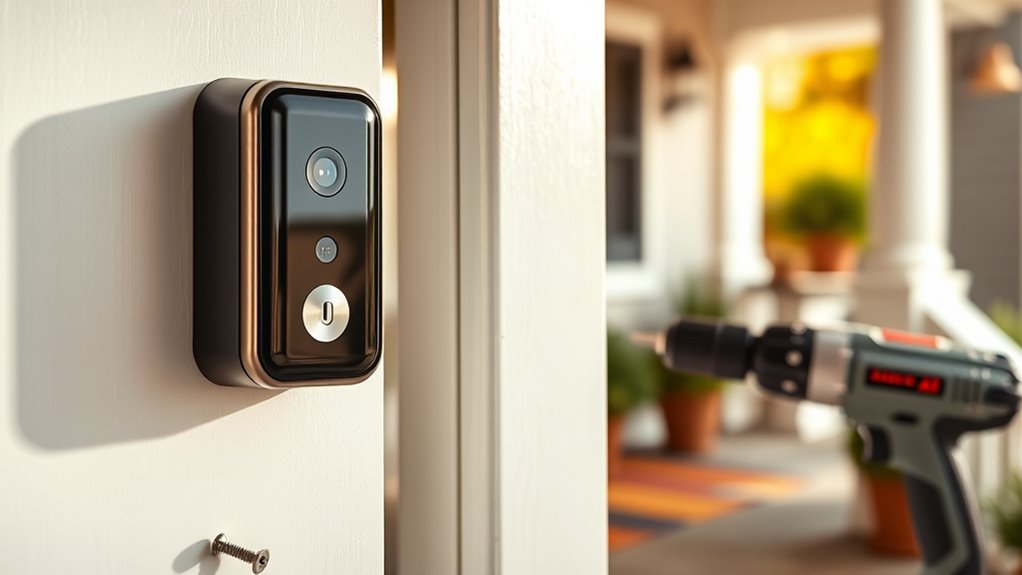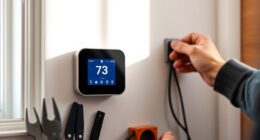For a successful smart doorbell installation, mount it about four feet high for the best camera angle and visibility. Check that your power supply meets the required 16 to 24 volts, and ensure a strong Wi-Fi signal of at least 5 Mbps for seamless operation. Take advantage of adjustable wedges for optimal camera position. Finally, customize your notification settings in the app to focus on important alerts. Keep going to discover more tips for a hassle-free setup!
Key Takeaways
- Install the smart doorbell at a height of four feet for optimal viewing of approaching individuals.
- Ensure the power supply meets the required voltage of 16 to 24 volts for proper functionality.
- Verify a strong Wi-Fi signal at the installation location, ideally with a minimum speed of 5 Mbps.
- Use adjustable wedges to enhance the camera angle and capture a wider field of view.
- Customize notification settings in the app to focus on significant activities and reduce unnecessary alerts.

When you install a smart doorbell, it’s crucial to mount it about four feet from the base of your door to ensure a clear view of anyone approaching, whether it’s guests or deliveries. This height helps capture the necessary footage and provides a better angle for the camera, which is vital for effective monitoring. If you’re using video doorbells, proper placement is key to getting the most out of the device.
Before you begin the installation, check the power requirements of your smart doorbell. Wired doorbells typically need a transformer voltage between 16 to 24 volts, so it’s essential to verify your existing power supply. You wouldn’t want to start the installation only to find out that your current setup isn’t compatible.
Once you’ve confirmed the power source, you can move on to the actual mounting. Ensure you have a strong Wi-Fi signal in the location where you’re installing the smart doorbell. Ideally, your Wi-Fi should have a minimum speed of 5 megabits per second for optimal performance. This speed is especially important during peak usage times when you want to maintain seamless video streaming and receive timely notifications.
If your signal is weak, consider using a Wi-Fi extender to boost connectivity. When you’re ready to secure the doorbell, utilize any adjustable wedges that come with the device. These wedges can help improve your camera angle, reducing obstructions and enhancing your field of view.
By adjusting the angle, you can ensure you capture not just the front porch but also the pathway leading up to your door. After the installation, don’t forget to check and customize your notification settings in the app. You can tailor alerts for specific activities like human detection or package deliveries, ensuring you’re only notified about what matters most to you.
Adjusting these settings helps reduce unnecessary alerts, allowing you to focus on significant interactions.
Frequently Asked Questions
How Do I Install a Smart Doorbell?
To install a smart doorbell, start by turning off the power at the circuit breaker.
If you’re using a wired model, remove the old doorbell and connect the wires to the new one.
For wireless versions, charge the battery and mount it where it’s easily accessible.
Adjust the angle for the best view, ideally around four feet high.
Finally, restore the power and test the doorbell to ensure everything’s functioning correctly.
Do You Need an Electrician to Install a Doorbell?
Deciding whether to summon an electrician for your doorbell installation can feel like standing at a crossroads.
If you’re diving into a wired doorbell, it’s wise to consult a pro to ensure safety and compliance with local codes.
However, if you’re opting for a battery-powered model, you can easily tackle the job yourself.
Just remember, handling electrical work without experience can be risky, so weigh your options carefully before proceeding.
Are Smart Doorbells Easy to Install?
Yes, smart doorbells are generally easy to install. You can choose between wired and battery-powered options based on your needs.
If you opt for wired, just ensure your existing doorbell wiring is compatible. Most come with user-friendly instructions and mounting hardware, so you can do it yourself without much hassle.
Just remember, good Wi-Fi signal strength is key for optimal performance, so double-check your connection during the setup!
What Are the Disadvantages of a Smart Doorbell?
There are several disadvantages to consider with smart doorbells.
You might experience issues with a weak Wi-Fi signal, leading to delayed notifications and poor video quality.
Privacy concerns can arise, as they continuously record footage, potentially capturing people without their knowledge.
If your smart doorbell is battery-powered, you’ll need to recharge it every six months, which can be inconvenient.
Additionally, some models may not work well with your existing home security system, requiring extra purchases.
Conclusion
In the grand tapestry of home security, installing your smart doorbell is a stitch that weaves safety and convenience together. You’ve transformed your doorway into a vigilant eye, watching over your home like a guardian angel. With just a few simple tools, you’ve painted a new layer of protection over your life. So, step back and admire your handiwork; you’ve not just installed a device, but you’ve crafted peace of mind, one ringing doorbell at a time.









